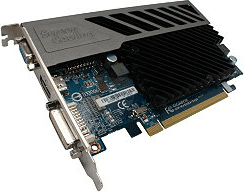Should You Use A “Fanless” Video Card?
 Something that’s still relatively new is the option of using a “fanless” dedicated graphics card. Fanless literally means the graphics card has a heat sink but no fan whatsoever. Sometimes you will also see fanless referred to as passive cooling.
Something that’s still relatively new is the option of using a “fanless” dedicated graphics card. Fanless literally means the graphics card has a heat sink but no fan whatsoever. Sometimes you will also see fanless referred to as passive cooling.
At the time I write this, Newegg carries 113 fanless cards, so you do have good choice when it comes to these. Before you run out and buy one however, you should be aware of a few things.
- Fanless does not outrun nor outgun top notch fan-equipped video cards. If you want the best possible video display ability, you’ll need to go with fans.
- Fanless can result in more heat within your PC case. Ordinarily you’re not going to encounter blazing-hot heat emitting from the heat sink on a fanless card, but if you’re trying your best to keep the temperature down, you’re better off with a fan-equipped card.
- Better fanless cards are large. Fanless cards with low-profile heat sinks typically do not have very good performance because they have to be engineered in a way that emits the least possible heat, therefore the video capabilities are watered down quite a bit. The core clock is significantly slower and the number of stream processors will be low. Fanless cards with tall sinks however usually have better capability but at the same time are large and may not fit properly in your case. Yes, it will fit in the slot, but what’s around the card (wires, case fans, other cards, etc.) is what matters.
- Windows Experience Index lies concerning fanless cards. This one I’m going to talk about more below.
My experience with a fanless card in Windows 7 64-bit
The fanless card I used was nVidia chipset-based with 512MB video memory and 16 stream processors. Based on the hardware I have, my Windows Experience Index rated my PC as a 4.3, which for all intents and purposes means “slightly above average”. In other words, not a blazer, but not a slowpoke either.
DVD and web-based video would play without issue. Windows Aero and gaming on the other hand wasn’t so great.
At the lowest possible graphics settings for Half-Life 2, being 640×480 with everything “turned off”, frames would drop after less than 10 minutes of gameplay.
Windows Aero would periodically stutter when displaying application windows. In addition, dragging windows from one monitor to the other (I have a dual-monitor setup) would also result in stuttering/pausing.
I finally said “Enough is enough!”, and went back to a fan-equipped card; this one in particular. I simply wanted a budget video card that would allow me to play games on average video settings and also stop the Windows Aero stuttering completely.
The card linked above did just that. I’m now able to play Half-Life 2 using widescreen settings with some decent in-game video options enabled, and Windows Aero doesn’t stutter anymore.
What’s interesting however is the Windows Experience Index rating I have now: 3.6. The drop came directly from the “graphics capabilities” report and nowhere else – yet my video performance is notably improved everywhere.
Like I said, Windows Experience Index lies. I never took that rating as gospel before, and this just further cements my belief that WEI is b.s. for the most part.
Should you use a fanless video card?
Even though I just gave fanless cards a thorough thumbs-down above, they do have two huge perks that cannot be ignored:
1. 100% silent
2. Likelihood of breaking is slim to none
The silence of a fanless card is obvious because it has no moving parts.
A fanless card is very unlikely to ever bust because there’s nothing to break on it. A fan is more or less the only liability on a dedicated graphics card, and being most graphics cards have fans that cannot be replaced, when that fan dies (and it will), you literally have to throw the card out and buy another one.
When considering using a fanless graphics card, it all depends on the application rather than the video ability required.
Examples of when fanless graphics cards serve a good purpose
Unfriendly computing environments
If the PC is going to be in a dirty environment, such as a wood shop or garage, it’s going to get dirty quickly and anything with a fan is a liability that will kill the computer in short order. Fanless is definitely more desirable here because it’s one less thing to break.
Entertainment Center PC
These type of computers should be silent, because you don’t want to hear fans while watching movies. Fanless cards can display DVD and video files easily, so in this setup, it’s a good fit.
Retrofitting for cheap long-haul computing
The lowest-priced fanless card is about 25 bucks. If you have an older computer box that you want to give slightly more “oomph” with some video hardware that basically never needs to be replaced for the life of the box, fanless is perfect in this respect.
On a final note, concerning my Windows Aero troubles with a fanless card noted above, bear in mind that’s Windows with all-on GUI graphics. Were you to use a fanless card on XP, you would not encounter any of the issues I did, because Aero is a Vista and 7 thing only.





















2 thoughts on “Should You Use A “Fanless” Video Card?”
In the years that followed, I used the D550 on a file server and then on a PC that I used to keep running all the time. It finally died on me last June, after years of honorable service (8 yrs).
In the years that followed, I used the D550 on a file server and then on a PC that I used to keep running all the time. It finally died on me last June, after years of honorable service (8 yrs).